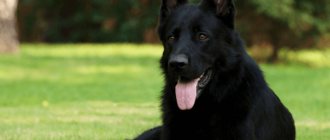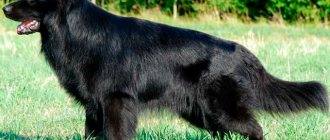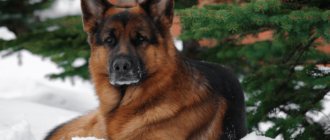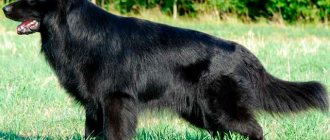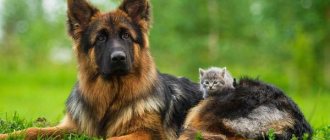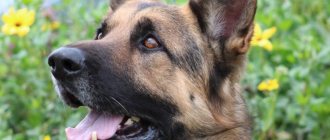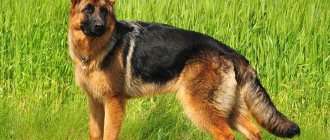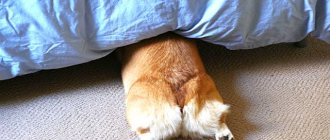The German Shepherd was bred to work and its working qualities are often the main criterion when choosing a future pet.
Currently, the breeding of these dogs is divided into exhibition and working.
Breeders of working lines focus on the performance qualities of their dogs, paying less attention to exterior characteristics.
Often in working lines there are dogs with an undesirable color and coat type for show dogs.
However, at the same time, they are distinguished by outstanding working qualities and are the holders of many diplomas from training competitions.
Origin story
By the 7th century AD In Germany, herding dogs similar to modern German shepherds already existed. These were large and strong animals, distinguished by their devotion to their owner, distrust of strangers and moderate viciousness.
These dogs were mainly used to herd livestock, but they could also perform other jobs, such as guarding the farm or protecting the owner.
It was they who became the founders of the new breed, when in the second half of the 19th century, targeted work began on breeding a universal dog, which became the embodiment of the best working and exterior qualities of ancient shepherd dogs.
In the first breed standard , drawn up in 1899, paramount importance was given to the working and service qualities of representatives of the new breed .
According to him, a German Shepherd should have a strong nervous system and character traits such as courage, confidence and inflexibility in achieving goals.
Subsequently, the standard was repeatedly rewritten, and when breeding show shepherd dogs, exterior characteristics came to the fore.
This is precisely the reason that some breeders, who believe that the dog’s character is of paramount importance, began to breed dogs that are distinguished by excellent working qualities, although they are inferior to their show relatives in appearance.
Nurseries
The most reliable way to purchase a healthy, purebred puppy with working functions is to visit a specialized nursery.
List of the most popular German Shepherd kennels:
Team Bulle Hof
The nursery has been operating since 2002. Located in Moscow. Has many awards and certificates. Breeders are engaged in breeding, preparation for exhibitions and training there. On the official website you can find all the necessary information.
Dog kennel "Rus Lindeshof"
The nursery was opened in Kaluga in 1988. It sells titled individuals. Dog handlers not only breed German Shepherds, but also Chihuahuas and Chow Chows.
Singer Rotwal
Representatives of the pet industry from Kazan. They are engaged in the breeding of German Shepherds, Toy Terriers and Rottweilers.
"SIEBEN WIND" RKF-FCI
Moscow mononursery. Was founded in 1987. Champions of Russia, RKF. They have awards and certificates.
"Police Dog"
Rostov-on-Don. Shepherd dogs are trained there for home guarding and law enforcement service.
Description and why they are purchased
The German Shepherd of working breeding is not created for conquering the exterior rings. But on the other hand, she is better suited to the most complex and difficult work than her show relatives.
It is these dogs that make wonderful service dogs used in the army, law enforcement agencies and rescue services. They are also used for their original purpose: they still graze livestock and protect them from predators.
People who are not related to the special services and the army also get such shepherd dogs . First of all, this is done by those who dream of playing sports with their pet.
And, indeed, German Shepherds of working breeding show outstanding results in various sports disciplines and in training competitions.
After all, strength and malice are combined in them with a strong temperament and an unshakable will to win.
People who do not want to engage in sports with their pet, participate in training competitions, or have no intention of using it to work in the special services, should not buy a working-bred shepherd dog..
Breeding
The main goal of a responsible breeder is to preserve the characteristics of the historical origin in the dog and place its young offspring in good hands.
Before mating, you should study the genetic background of the bitch and the dog. They both must be healthy and purebred. You cannot take close relatives for mating. This is the only way to achieve compliance with standards.
For a pregnant bitch, a place should be organized in advance and the diet should be prescribed. If an enclosure is used for future puppies, then it must be warm, clean, without unnecessary objects, and meet hygiene standards.
After birth, babies are examined by a doctor to identify possible defects or diseases. Frail, lethargic German Shepherd dogs are being removed from sale. You need to pay attention to the mother's nutrition during breastfeeding. The future of the offspring depends on this.
This is interesting: When does a German Shepherd puppy's ears stand up?
For maximum benefit, individuals must be well-groomed and tidy. The coat is combed, the muzzle is clean. It is worth taking care of the documents. They must indicate information about the nursery, parents, characteristics, vaccinations.
Pet character
The working German Shepherd has a strong temperament and is highly people-oriented. She works not under compulsion, but at will.
This dog is not afraid of the most difficult conditions and heavy physical activity . Shepherd dogs of working breeding are stress-resistant and hardy, they rarely have nervous breakdowns.
NOTE!
At the same time, these dogs are more vicious and stubborn than show dogs; in addition, they are more active and require more physical activity.
A working-bred shepherd dog needs a strong and confident owner; in addition, these dogs must be trained professionally.
Tips for choosing a puppy
You can verify the purebredness of the baby using official certificates. Often the breeders themselves sell small purebred German Shepherd puppies. You can also contact a reputable breeding kennel to be sure of the puppy's health and development.
Signals confirming good health are a good appetite and good appearance. There should be no obvious aggression or too slow reaction to the environment. It is important to see the parents of small animals, take a closer look at their appearance, general condition, and observe the behavior of other kids.
Breed standard
Height ranges from 55 to 63 cm, weight – from 22 to 35 kg .
The body shape is a little stretched. The length should exceed the height at the withers by 10-15%: these are the proportions that ensure the dog’s greatest performance and endurance.
The muscles are well developed, making the dog look strong, agile and agile.
The head has the appearance of a narrow wedge tapering towards the nose . The ears are erect, medium in size, wide at the base. The nose is not too large, black.
The jaws are strong and powerful. The teeth are complete, large, white and strong. The bite is regular, scissor-shaped. The eyes are small, oval, preferably as dark a shade as possible.
The neck is muscular, strong and strong, set at approximately 45 degrees. The back is straight and level, the croup is only slightly sloping (15-20 degrees).
The main external difference between a working shepherd dog and a show dog is not a convex, but an almost straight line of the back . The croup also does not have such a strong slope as in show dogs.
The tail is slightly curved and reaches the hocks.
The forelimbs are straight and even, located at right angles, and the hind limbs are slightly set back.
A shepherd dog of working breeding can have either rather short and stiff or long and softer hair .
Expert opinion
Kozhevin Semyon Kirillovich
Expert dog handler.
“Work-bred German Shepherds have a bolder and tougher character than show-bred dogs. They are more energetic, resilient and mobile. Dogs with a melancholic or phlegmatic character are excluded from working breeding, as well as those that do not have great endurance and psychological stability. But, despite the fact that working shepherd dogs have such attractive qualities, they cannot be kept as companion dogs. These animals live for work, and if the owner cannot provide the pet with an activity that requires the application of its innate qualities, it is better for him not to buy such a dog.”
Interesting Facts
- Descendants of German Shepherds from Scandinavia. But the blood of wild wolves also flows in them. Greif is the first representative of the breed to be shown in Hannover at an exhibition in 1882. The founder of a separate species was Max von Stefanitz.
- German Shepherds are excellent shepherds. Their historical purpose was to protect sheep. But during wars, they became experienced soldiers at the front.
- These individuals were not only participants in military operations. They worked as sappers, orderlies and signalmen. One dog, named Khan, was even awarded a medal for courage and bravery.
- The German breed is officially recognized as one of the three smartest in the world. Only representatives of the collie and the poodle were able to get around it. The ranking was compiled by British University psychologist Stanley Coren.
- A strong jaw is a hallmark of the German Shepherd. The bite is 100 kg. According to this value, only Rottweilers and some Pid Bulls are ahead of them.
- In Russian Tolyatti, residents erected a monument called “Devotion.” It is dedicated to the German Shepherd. Canadian architects have recreated the image of a four-legged creature, reminiscent of dead police dogs.
- These dogs are often featured in films and TV series. They play the role of assistants to the detective department.
This is interesting: TOP 20 smartest dogs in the world
This is interesting: TOP 20 smartest dogs in the world
Basic colors
The main color is zone-gray , although there are also dogs of other shepherd colors: zone-red, black and tan, black and saddle.
For a working shepherd, color is not particularly important, since when breeding them, the emphasis is on physical and psychological characteristics.
Key points in training
German Shepherds are very smart and quick-witted dogs. But training will not be a simple task, because this breed is characterized by cunning and resourcefulness. If the puppy is raised correctly, the process will become easier. You can contact dog trainers or a training school to get advice and help in controlling your pet.
- First of all, the owner is obliged to show his leadership. But this will not be enough. The shepherd must constantly see that people are the main ones in the house. This can be expressed through strict but fair treatment, a ban on resting in human beds and feeding after the household has had dinner.
- By four months, the pet should know its daily routine, name, and diet well . If the owner decides to train the dog on his own, then from 3-4 months you can start learning basic commands. 10-year-old child can handle raising a shepherd , but it is better to carry out training under adult supervision.
- If highly specialized training is planned (for example, for service in the border troops), the dog is given to trained people who train in the pet those aspects and qualities that will be useful in work.
Read about how to properly train a shepherd in the article: “How to properly train German Shepherd puppies: the basics of education from a dog handler.”
Advantages and disadvantages
pros:
- Hardy and efficient.
- Selflessly devoted to their owner.
- Mentally stable.
- Unpretentious in food.
- They are easy to care for.
- They make wonderful working or sporting dogs.
- Show high results in sports championships and training competitions.
Minuses:
- They don't look as impressive as show dogs.
- They require enormous physical activity and work.
- If raised incorrectly, they can grow into animals that pose a potential danger.
- The owner of such a shepherd can only be an adult and physically strong person with pronounced leadership qualities.
- Cannot be kept as companion dogs.
A working breed dog is only suitable for active work . Even for use as a home security guard, it is not recommended to use it.
Professional athletes
Working breeding allowed shepherd dogs to acquire sporting qualities: high reaction speed, controllability, desire to work in tandem with a person, and effective execution of commands. Big sport dictates its own rules, and the emphasis is on developing interest in work, sufficient temperament, with a certain degree of rigidity in character, and perseverance in goals.
Any deviation from the desired behavior is suppressed, the dog actually turns into a robot aimed at achieving victory.
How to treat children and pets
A properly raised working-bred shepherd dog is good with children, but this does not mean that it can be used as a nanny dog.
However, these animals willingly take part in active games and are ready to protect their little owners, not sparing their lives.
These shepherds are pets without excessive aggression . But it is unlikely that such a dog will be supportive of a strange dog or cat entering his territory.
Distinctive features
Recessive genes and a rich breed line divide the breed into subspecies:
- West German (main species);
- East German (larger and more powerful than the main type);
- Eastern European (bred by Soviet cynologists);
- Belarusian or black (bred in Belarus);
- Long-haired;
- Dwarf.
International cynological organizations recognize only the West German dog. Other subspecies have either partial recognition or only amateur clubs.
The West German German Shepherd is considered the standard and most correct. She is quite large ( 55-65 cm at the withers) and heavy ( 22-40 kg ). Initially, dogs were divided into large and small, but over time they were all reduced to one standard. The dog has a stretched format. The bones and muscle structure are strong and well built. The standard was last revised in 1996.
- The head is harmonious, wedge-shaped, moderately wide, moderately rounded. Proportional to the body. The cranial bones are visible, a groove is visible. Stop is expressed.
- The muzzle is equal in length to the skull. Tapers towards the nose. The bridge of the nose is straight. The lips are dense and thin. The jaw is strong and not wide. Scissor bite (the upper teeth completely overlap the upper teeth).
- The nose is large and black.
- The eyes are small, almond-shaped, slightly slanted, and set wide apart. The color of the iris is dark.
- The ears are medium-sized, stand on cartilage, parallel to each other and perpendicular to the head. Tapered and rounded at the ends. When running they can fold back.
- The body is strong and massive. The topline is curved and smooth. The back is inclined, smoothly transitions into a long sloping croup. The chest is well let down and the ribs are rounded. The neck is of medium length, moderately inclined (about 45° to the horizontal), wide, without dewlap.
- The tail is of medium length (reaches the hock joint), lowered in a calm state, rises slightly above the horizon line in an active state, but does not bend, surrounded by elongated hair.
- The limbs are straight, parallel, strong, muscular. The movements are sweeping, similar to the gait of a trot.
- The coat is thick, smooth, hard, and of medium length. Elongations and feathering on the neck, tail, and back of the thigh. Dense fluffy undercoat.
- Colors: pure black, black and tan, black with yellow or red spots.
Life expectancy, illness and health
Life expectancy is, on average, from 10 to 14 years .
When breeding working line shepherd dogs, breeders try to use only healthy dogs that are not carriers of hereditary diseases.
Nevertheless, albeit infrequently, such a shepherd may be predisposed to the following ailments:
- Diseases of the gastrointestinal tract.
- Hip dysplasia.
- Hind leg failure.
- Allergies are mainly food allergies.
- Dermatitis caused by improper feeding.
- Otitis.
Working dogs are more likely to suffer from various types of injuries than show dogs . They also experience sunstroke, heatstroke, frostbite, and colds associated with working in difficult conditions.
Features of character and behavior
Shepherds are truly excellent working dogs because they are obedient and able to obey several people when other breeds choose a single owner. Their intellectual abilities allow them to carry out commands of varying levels of complexity. Such animals are multifunctional and, in addition to their security and protective functions, can be nannies, guides and simply companions.
Many films and works of fiction are dedicated to the courage and devotion of German Shepherds. They really deserve such attention.
Advantages
- Each individual belonging to the breed has its own individual temperament and character. Therefore, you can buy the puppy that is closer to your liking. You can find out which type (sanguine, choleric, phlegmatic or melancholic) the dog belongs to from the breeder.
- All shepherd dogs have a strong build and good physical shape. They are fast and strong. In addition, they have high intelligence, which allows them to raise and train the dog the way the owner needs. Very hardworking.
- Properly raised shepherd dogs are calm and balanced. They treat their family well, love children, and do not terrorize other animals.
- Sociable and easy to socialize. They tolerate changes of environment well.
- Noble, not vindictive and generous.
Flaws
- The disadvantages of the breed include high aggressiveness . Without proper training, a dog will bite and attack without a reason. Therefore, mandatory long-term training is the most important point in keeping shepherd dogs.
- Very active. Such dogs love to run and cannot sit idle. It is impossible to lock such a pet in an apartment and make it a sofa pet. In the case of such content, “Germans” need regular active walking and training.
- They do not like loneliness and are not suitable for busy and sedentary people. Shepherd dogs require constant movement, they are perfect for travel and sports.
Basic rules of care
You need to bathe your shepherd as needed and no more than once every two months. But you need to comb the fur with a brush more often: 3-4 times a week, and when your pet is shedding - every day.
The dog's ears, eyes and teeth are examined daily, but are cleaned only when they become dirty . The claws of working shepherd dogs usually do not need to be shortened, as they grind down on their own.
But if you still need to trim them, you should use a nail clipper for large dogs.
A working shepherd dog must be vaccinated in strict accordance with the vaccination schedule.
Cost and where to buy
The price for one German shepherd in Russia varies from 4 to 600 thousand rubles. and depends on many factors:
- place of purchase;
- color type;
- age;
- pedigree;
- title.
In Moscow or St. Petersburg, sellers raise prices. In Omsk and Novosibirsk the cost is much lower.
Breeders offer dogs of the following ages:
- 2-3 months;
- Six months;
- 8-10 months
The older the individual, the lower the cost. It is not recommended to take very tiny babies under 90 days old. They still cannot be without a bitch.
If a German is considered as a future title holder, then preference should be given to serious single-breeders. But the cost of the puppy in this case will be higher.
To protect your home and family, you should take a closer look at the adults. They are already trained and ready to work. The price for a trained bodyguard can be higher than for a puppy. But you won’t have to pay extra for professional training.
Training and education
The owner of such a dog must have the qualities of a leader and from the first day let the pet understand what it can do and what is prohibited. The whole family must strictly adhere to this strategy and not give the shepherd any concessions, indulging its whims.
IMPORTANT!
Much attention should be paid to the socialization of the pet: to teach it to treat other animals and strangers calmly.
It is unacceptable to try to teach a puppy special skills ahead of time, as you can easily ruin his psyche or make him too aggressive.
Reviews
Irina, Moscow: “My acquaintance with shepherd dogs happened in 2010. We chose a puppy and he immediately became our best friend. A completely unpretentious, obedient and intelligent dog. There is no need to spend a lot of money on maintenance and expensive food. If you haven't gotten yourself a dog yet, then think about this wonderful breed. This is a very loyal and intelligent friend, and also a good guard.”
Irina, Moscow: “My acquaintance with shepherd dogs happened in 2010. We chose a puppy and he immediately became our best friend. A completely unpretentious, obedient and intelligent dog. There is no need to spend a lot of money on maintenance and expensive food. If you haven't gotten yourself a dog yet, then think about this wonderful breed. This is a very loyal and intelligent friend, and also a good guard.”
Maxim, Sochi: “German shepherds are very reliable animals. Therefore, you can live peacefully with this dog and not worry about your safety. She won't touch anyone without a command. If you want a devoted and faithful friend to appear in your family, I advise you to get this breed. You will not regret".
It is difficult to find a more devoted and loyal friend than a German Shepherd. She will become a companion to the owner, a nanny-bodyguard for small children and a formidable home guard. With proper care, the pet will delight the family for many years.
The gallery contains photos of German Shepherds of various colors. Puppies and adults are presented. In the video you can observe the grace and behavior of these individuals.
How to feed
You can feed such a shepherd either super-premium or holistic food for large active dogs, or home-cooked food.
Due to heavy physical exertion, a working dog needs food rich in protein, which is why the share of lean meat and offal in its diet should be no less than 40-50%.
It is also necessary to give your pet cereal, vegetables, herbs and dairy products.
CAREFULLY!
You cannot feed your pet pork, smoked meats, sweet, salty or spicy foods.
Diet
Before breeding German Shepherds, you need to understand their diet. Such animals are fed the following products:
- raw, boiled or frozen meat;
- rice, buckwheat or oatmeal;
- fermented milk products;
- boiled vegetables.
Raw meat is the basis of any dog’s diet
. Important! It is also necessary to add dry food to the diet. It is better to choose food that contains a large amount of offal and meat.
Price range
The cost of puppy with RKF documents, depending on the region, starts from 15 and reaches 40, and sometimes higher, thousand rubles .
When breeding German Shepherds of working lines, breeders focus not on external data, but on the working qualities of these dogs. They are characterized by increased endurance and are able to work in the most difficult conditions.
Working shepherd dogs need to be trained from an early age.
And, of course, you should not buy such a dog as a companion, since a working shepherd dog needs a lot of physical activity.
German Shepherd working breeding in the apartment
If a dog is kept in an apartment, it needs to be provided with conditions for a comfortable life. A lounger for relaxing and sleeping is placed in a cozy place away from drafts and heating appliances. The German is taken for a walk at least twice a day. The duration of the walk is about two hours. They train and practice skills on the street. Living in a house, the dog guards it, gets along with all family members, but there are also disadvantages - it sheds, and the fur has to be cleaned regularly. In the absence of physical activity, he behaves actively, and when left alone, he worries, his psyche suffers.
Feeding
To maintain activity, a service dog needs high-quality nutrition. Depending on the intensity of physical activity and the weather, they are fed 1-2 times a day. They use super-premium dry food and holistic products or ready-made meals from natural products. The menu should include lean meat (half the diet), cereals, herbs, kefir and cottage cheese. It is unacceptable to give spicy, smoked, salty, sweet and fatty foods. Clean water should be available around the clock.
Bathing
When a dog lives in an apartment, it is bathed no more than three to four times a year. More frequent water procedures are necessary for a German shepherd with an irrepressible temperament - if it gets into the mud or fights while walking or while performing official duties. But even in this case, you don’t have to bathe the whole thing, but just wipe it with a brush and towel. Frequent washing leads to dry skin and reduced coat quality.
Walk
You need to walk your German Shepherd only in specially designated areas, after putting a muzzle on it and fastening it on a leash. Walking should not be limited to just fulfilling natural needs. Two-hour walks are combined with training, running, jumping and games. During walks, the dog must communicate with other dogs. If the owner likes to ride a bicycle, the shepherd dog can run alongside.
Vaccinations
Prevention of diseases is impossible without vaccination and treatment against external and internal parasites. The first comprehensive vaccination is given to German Shepherd puppies at the age of 8-10 weeks. It is directed against enteritis, hepatitis, parainfluenza and plague. After 2-3 weeks, the dog is revaccinated. After changing teeth to permanent ones, they are vaccinated against plague, adenovirus, leptospirosis and rabies.
Nutrition
For four-legged working animals, the quality of nutrition is of great importance, since in order to maintain excellent physical shape it is necessary to feed the pet a balanced set of foods. Puppies under 4 months of age are fed 4 or even 5 times a day in small portions.
The basis of their diet should be low-fat dairy products - cottage cheese, milk, kefir, and, of course, a source of protein - low-fat chicken or minced beef. The ratio of meat and dairy products should be approximately 50/50. After 4 months, the grown puppy is transferred to 3 meals a day, adding boiled chicken eggs and grated vegetables to the main diet. A dog that has reached 8 - 9 months of age is fed twice a day.
Content
Germans of working breeding, as a rule, are kept in outdoor enclosures, fenced areas or premises of those organizations where dogs serve. Dogs can also live in ordinary city apartments, provided they receive regular training and long walks outside. Sports exercises on a special area for dogs will help preserve and develop the dog’s physical abilities. Daily practice of commands and obedience skills is required.
Famous and rich
In France, a monument to a shepherd mountain rescue dog named Flambeau has been erected. The dog took part in the fighting of the First World War. All of Flambeau's descendants died during the battles of World War II.
Irma, a German shepherd, in 1945. looked for people in the ruins of London , damaged by bombing. For which she was awarded a medal for rescue.
Fighting dogs, students of the Central School of Military Dog Breeding, took part in the 1945 Victory Parade on Red Square. Lieutenant Colonel Alexander Mazower, chief dog handler of the International Federation of Service Dog Breeding, took part in the procession. He carried in his arms a wounded shepherd dog named Dzhulbars, wrapped in the overcoat of Supreme Commander-in-Chief Joseph Stalin. The mine-detecting dog Julbars was awarded the medal “For Military Merit” for the exploits performed during the liberation of Romania, Hungary, Austria and Czechoslovakia.
According to the Guinness Book of Records, the richest German shepherd , the dog Gunther IV, lived in Italy. He inherited his $372 million fortune from his father, Gunther III. Gunther III's owner was so enamored with her dog that she left him her entire inheritance.
This is their job
The best working qualities of German Shepherds appeared during the First World War. Signal dogs delivered reports and documents under heavy fire. They carried ammunition and repaired damaged telephone lines using reels of cable. The paramedic dogs discovered the wounded man and grabbed the soldier’s personal item in their teeth as a signal that the person was alive. Then they escorted help to the victim.
In Indochina, during the liberation war, a special parachute unit . The soldiers assigned to this unit were German shepherds. The four-legged warriors not only mastered parachute jumping, but could also perform a combat mission after landing.
The German Shepherd is one of the breeds with the most acute sense of smell. Her olfactory memory stores up to a thousand odors. This unique quality allows you to work in the canine service of customs and the Ministry of Emergency Situations, find drugs, explosives and weapons by smell, and search for people affected by explosions in the rubble.
The farm and all my father's property have been guarded by German shepherds for a long time. They regularly perform their service dog duties . They have proven their love and devotion to their owner more than once. A better guard and herding dog cannot be found.
Breeding
In nature, there are interbreed and purebred sampling techniques. Modern breeding uses purebred crossing, which in turn is divided into:
- outbreeding;
- inbreeding;
- linebreeding;
- outcrossing.
Let's look at the pros and cons of these breeding methods.
Outbreeding
Only purebred German Shepherds without common ancestors participate in mating. From two unrelated lines, one representative of different sexes with the same characteristic features is selected.
Despite its closeness to nature, this breeding method has a huge disadvantage - there is no guarantee that the offspring will have the same characteristics as the parents.
Outbreeding is not often used due to the fact that over time, German shepherds that are far from the standard begin to be born.
Inbreeding
This method of breeding is most suitable for a professional, since a strict selection of applicants is necessary. As a result, strong lines of families with well-developed important properties are created.
Producers of purebred offspring are immediate relatives.
Linebreeding
The most successful way of mating German shepherds that have a common ancestor of the third generation is called linebreeding. This kind of crossing is also called linear crossing.
A male dog must have the ability to pass on important characteristics to future offspring. This recurrence is called prepotency.
Outcrossing
The mating should involve individuals with common ancestors in the fourth or fifth generation. These conscious actions are carried out to replenish the breeding fund with a dog of one kind or another, which carries the abilities necessary for the breeder.
